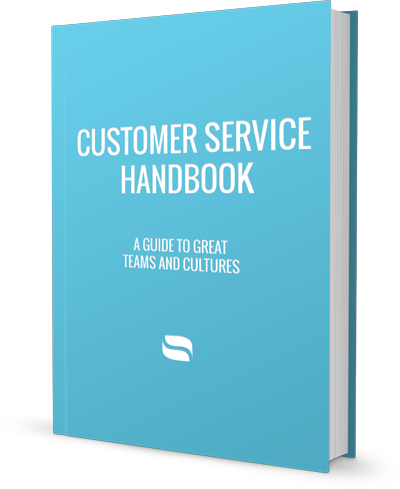







Inevitabilities
This is a part of a continuing series that is also available as a downloadable eBook here. We talked to 35 companies, including Stripe, Twilio, and Mailgun, to get a sense of what it takes to run a great customer support organization. While every company is different, there were some trends that we could identify as benchmarks for great customer support.
The Looking Glass
Before we get started on more tangible inevitabilities, we want to address one of the biggest inevitabilities we believe is important for how businesses ultimately want to portray themselves.
Small businesses want to appear large, large businesses want to look “enterprise”, and enterprise businesses will do anything to feel small. This inevitability has transformative implications for how a business, as well as its support team, shapes its culture. For us, we don’t feel there is a need to be something we’re not simply because it’ll never be who we are. The need to remember and embrace who we are and where we came from is far more important for where we’re going. Hopefully this will be a good lesson to keep top of mind.
Phone Support
Having a public facing phone number will need to be seriously considered at some point. Customers sometimes feel more confident knowing there are real people they can talk to. Unfortunately, there is no right answer for when or whether you should even have one. It depends entirely on what phase the business is in, the growth of personnel, priorities, and maybe even philosophical beliefs. Many businesses avoid having a phone number since it can overburden support teams. This is understandable if your support team is small. That said, as a growing small business, phone support can be quite charming if done correctly. Here is our advice for approaching phone support:
- Try it out with everyone on your team. Everyone should at least be comfortable speaking to customers over the phone.
- Pick a number that’s easy to remember.
- A/B test different strategies for how customers might stumble upon your phone number in order to gauge its attractiveness. Reamaze is still in this testing phase.
- Once you’ve settled on a strategy, display your phone number prominently to better gauge its scalability early on.
- Once you’re fully invested in offering phone support, make sure someone is able to personally pick up. Use this to your advantage. No machines, no automatic routing. This helps keep you true to your customer support bandwidth.
- Clearly state your hours of availability.
- Have a way to log phone calls with customers as conversations in your system. Sending a follow up to the customer with a recap of the conversation is a great way to do this.
- Be transparent to customers about how you’re handling phone support.
24/7 Support
In a survey conducted by the Customer Contact Council in 2012, 965 B2B customers and 879 B2C customers perceived more value in access to customer support seven days a week than access to customer support 24 hours a day but for only five days a week. Customers seemed to prefer having more flexibility in the number of days they can contact you rather than the sheer amount of hours.
Corporate Executive Board (CEB)
"So the answer seems simple enough (provide certain service hours, 7 days a week), but what about providing 24/7 service and support for urgent issues, or what about using 24/7 as a business differentiator? Interestingly enough, in conversations specifically with B2B order management and technical support organizations, whose businesses often hinge on immediate availability of support, the general trend is not necessarily to provide 24/7 support. In fact, most B2B organizations take a very discriminate view toward expanding hours of operation. And they consider self-service information and tools available on the Web and in the knowledge base as a key part of these strategies, meaning that 24/7 support doesn’t necessarily have to mean 24/7 LIVE support."
Whether or not you decide to adopt 24/7 support ultimately depends on your type of business, your teams’ bandwidth, and your overall resources. Here are some things to look out for:
- Evaluate fit (does it work for you?) and finish (can you do it well?).
- Don’t over extend your team. Never just assume that your customers would love 24/7 support.
- Pilot everything.
- Be transparent about your policies for 24/7 support. Does it apply to just email? Phone?
- Suggest alternative ways to find answers and information that's complimentary to 24/7.
Courtney @ Eventbrite
"When I joined the client services team in early 2010, there were only 5 of us and the hours of phone and email service were from 6am – 6pm M-F. Over time, we expanded to support weekends, and at the end of December 2011, we went 24/7 by adding evening shifts as well as a London team. It’s been so exciting to see the growth, and it feels great be there for customers any time of day."
Service Level Agreements (SLA)
If you’re married, you already know all there is to know about SLAs. They’re really no different. We kid.
To be perfectly honest, for a startup, we recommend honesty and transparency over professional SLAs. It’s likely that customers are okay with running along with you. As you grow in size, investing in a plausible set of customer support SLAs can be used as a major service differentiator and marketing centerpiece for quality and reassurances. There are usually two schools of thought regarding SLAs:
- SLAs are mostly hollow promises; you can have one, but at the end of the day, all that matters is how you treat customers, how honest you are, how helpful you are, and how willing you are to go the extra yard. In worst case scenarios neither you nor your customers will be pointing to SLAs but working toward to fixing the problem.
- SLAs are integral parts of your product offering. Not only are you required to have one in certain cases but they can actively protect your quality and professionalism. Great SLAs can substantially set you apart from competitors and become a revenue generator.
Performance and Analytics
Analyzing the performance of your customer support team is only as important as their ability to keep customers happy and to focus on maintaining a customer-focused culture. And while it is sometimes necessary to keep track of individual staff performance, we find it counterproductive in most cases to make this type of analytics the centerpiece of measuring effectiveness.
Instead of creating urgency and punishing poor performance, encourage your team to function as a team where the ultimate goal is to create awesome and lingering experiences for customers. Focus your metrics not on individuals but overarching themes for what defines great support. For example, focus on getting back to customers faster as a whole, achieving a certain amount of satisfactory feedback as a team, and resolving a certain amount of volume in any given week. These fun and meaningful milestones not only take away pressure on individuals (where everything can become a chore) but also encourage cohesiveness among teammates.
Jason @ Twilio
"I care about our response time metrics and whether we’re keep it up to our internal/external SLAs. Our customer satisfaction scores and tracking everything against that is important as well. Everything else is support information. But those two are the most important. Redundancy, scalability, and hiring are all core to our business. We focus on sharing knowledge and sharing volume as a big part of scalability."
It’s very likely that these strategies may require more attention and modification as your business grows. If so, don’t be afraid to measure more. Knowing and understanding more about how your team is performing can add tremendous value in the long run. However, strive to not lose focus on the why you’re measuring or analyzing.
The Toxic Customer
Every company deals with a fair share of them. You know, the ones with proactive rudeness, sudden and out-of-the-blue requests, impossible expectations, and an unlimited arsenal of irrelevant questions. It’s inevitable. And strangely enough, having toxic customers can be a great blessing in disguise. But let’s get one thing out of the way: nobody enjoys supporting toxic customers.
We’re here to tell you that you should (at least once in a while). Toxic customers are the epitome of stress-testing your quality of service. How will your team keep its composure? How will you deal with absurd requests? How will you say NO to them? What else can you expect them to ask for?
We’ve compiled several strategies over the past few months about how to deal with toxic customers:
- Be more toxic than they are. This doesn’t sound as bad as it does. Being more toxic than a toxic customer is about extending the quality of your support beyond its normal boundaries. Be more attached than they are, ask more questions than they do, and pay more attention to them than they to you. Fight “poison” with “poison”. Toxic customers have a threshold and your only path to liberation is to find that threshold and break through it with an overwhelming amount of love.
- Tackle toxic customers by gamifying the process. As soon as a toxic customer is detected, huddle up a taskforce and enjoy an interesting meeting about a possible angle of approach. Take on toxic customers as a team and enjoy the learning process.
- Maintain your composure and be sure not to piss off a toxic customer. Toxic customers are very outspoken, hence the toxicity. They’re not afraid to voice their opinions. Treat them with the utmost respect and courtesy.
- Get them off your back early. If you’ve decided not to deal with a potentially toxic customer, it’s always better to let them know as early as possible. Be firm but courteous.
Chapters
How's your customer support?
We build brilliant customer support software for companies like yours.
Stop wrestling with ticket numbers and start delighting customers with Reamaze, our cloud helpdesk.
We wrote the book on Customer Support
Literally.
Our book includes interviews with some of the top customer support organizations in the industry and shows you what it takes to deliver consistent, high-level support, whether you're a one person startup or a Fortune 500 enterprise.

Get our eBook under "Official Downloads"
Join thousands of teams using Reamaze to impress customers.
Find out how with a free account.
